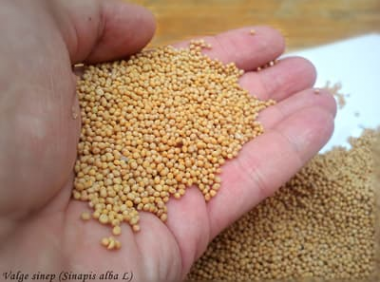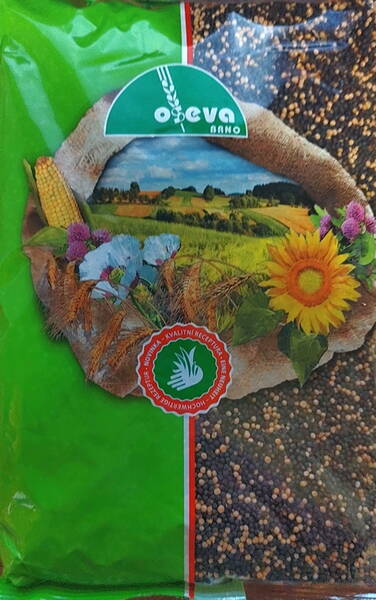Ex Tax: 3.15€
A fast-growing green crop that excels as a green manure.
a productive and fast-growing crop that can be sown from early spring to late autumn. In 1.5 months, it goes through all stages from germination to flowering, reaching 1.5-1.8 m in height.
Oil radish grows quickly and builds up its green mass even in the cold season. Late sowing is also well tolerated. In one season, you can get 2-3 cuttings. Oil radish not only binds nitrogen well, but also destroys pathogens of some diseases and actively suppresses soil pests (wireworms, nematodes) due to the increased content of essential oils.
Due to its rapid growth, it also clogs weeds, even such formidable ones as wheatgrass. It has a powerful tap root system, which is able to enrich and loosen not only the surface layer of the soil, but also deeper layers, thereby pushing out weeds and wheatgrass. Water and air permeability in the soil improves, with excellent frost resistance, does not allow the soil to freeze too deeply, while retaining snow. Oilseed radish can be used as a nutritious animal feed because it contains a lot of protein.
Possesses melliferous properties, attracting bees even in cool weather. The oil radish has very thick leaves, which often lie under their weight. It blooms with yellow or white flowers, after which pods are formed, in which the seeds ripen.
Oil radish is sown as a green manure from April to September, for winter crops, but the later the sowing, the worse the result, the soil will receive less green fertilizer, since the aboveground mass will not have time to grow, therefore, the best time for sowing oil radish is still spring. The seeds are deepened by 2-4 cm, keeping the distance between the rows 15-30 cm. You can also sow in bulk. After 5-7 days, seedlings appear, and active growth of the aerial part begins. The first mowing is carried out before flowering, approximately 30 days after sowing.
Bot. syn.: Raphanus sativus var. oleiferus Stokes.

* White mustard or English mustard (Sinapis alba) is an annual cruciferous oil plant that has the ability to release poorly soluble phosphates. It can grow on any soil: pH from very acidic to alkaline.
Seeds germinate at + 3 ° C. Seedlings can withstand short-term frosts down to -5 ° C.
Mustard rises quickly and grows quickly. The green mass is mowed when the leaves of the plant are fresh, juicy, preferably before mass flowering, because when harvesting at a later date, the leaves will begin to die off and the organic mass will decrease, and the ripened seeds will clog the garden bed.
On average, the period from sowing to embedding of mustard in the soil is 55-70 days (8-10 weeks). It is better to embed it in the soil or dig a little, and by the fall everything will have rotted.
Seeding rate of seeds is 2.5-4.0 g / m2. The depth of planting in the soil is 2-3 cm (sowing is lightly sealed with a rake into the soil).
The next culture is planted no earlier than 3-4 weeks after the planting of the green mass. It is also important the phytosanitary effect of mustard - after planting it, the incidence of plants with such common diseases as late blight, rhizoctonia, tuber scab, fusarium rot, incl. and potatoes.
Sowing of mustard reduces the number of wireworms in the soil, it is also recommended to plow white mustard in late autumn, as a result of disturbed wintering of the wireworm, its death occurs.
To increase the effectiveness of the fight against the wireworm, the seeding rate of mustard is increased to 5.0 g / m2.
In recent years, many farmers refuse to use manure. It is not easy to get it in the right quantities, the labor intensity is high and the price is high. Moreover, the contamination of the site with weeds (in the case of manure application) will force the use of herbicides or exhausting weeding. In this case, green fertilizer will serve as a serious alternative to manure.
Green fertilizer is understood as green manure crops, the fresh plant mass of which is used for fertilization (plowed) to enrich the soil with organic matter.
Bot. syn.: Brassica hirta Moench, Sinapis alba L. subsp. alba.
* What are the benefits of siderates?
Siderata stop the leaching of nutrients outside the root layer, pump nutrients from the deep horizons of the soil into the upper layer, and contribute to the accumulation of humus in the soil, which improves its properties. The more humus is contained in the soil, the lower its thermal conductivity and higher heat capacity, less physical evaporation of water from it, more productive use of soil moisture by cultivated plants. Humus contributes to the intensive development of beneficial soil microflora.
The biomass of the root systems of herbaceous plants plays an important role in enriching the soil with organic residues. When green fertilizer is applied, not only nitrogen, but also other nutrients are accumulated in the soil. Green fertilizer in the soil decomposes much faster than other organic fertilizers rich in fiber. Green fertilizer slightly reduces the acidity of the soil, significantly increases the permeability and moisture capacity of the soil, as a result of which the surface runoff of precipitation decreases and the moisture content in the soil increases sharply. As a green fertilizer (siderates), the following are mainly cultivated: lupine, sweet clover, mustard, alfalfa, phacelia.















